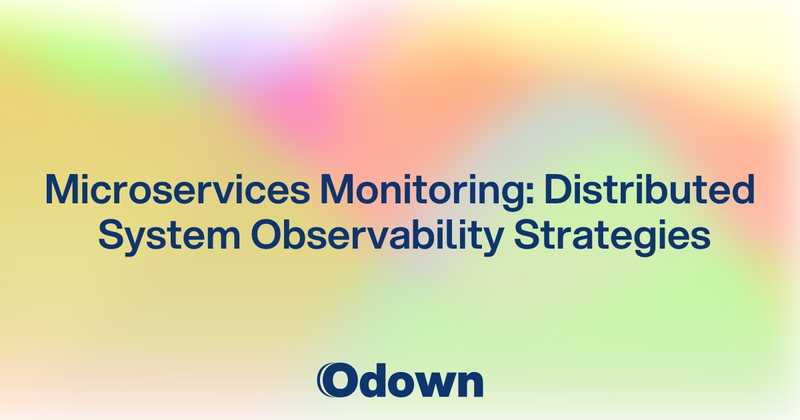Microservices Monitoring: Distributed System Observability Strategies
Your monolithic application was easy to monitor. When something broke, you knew exactly where to look. Performance problems had obvious causes. User requests followed predictable paths through your codebase. Debugging meant setting breakpoints and stepping through code linearly.
Then you moved to microservices. Now a single user request might touch fifteen different services across three cloud providers. When checkout breaks, the problem could be in the payment service, the inventory service, the user authentication service, or some subtle interaction between them that only happens under specific conditions.
Traditional monitoring approaches collapse under microservices complexity. You can't monitor each service in isolation because user experience depends on all services working together correctly. You need monitoring strategies that understand distributed systems, track requests across service boundaries, and help you navigate the complexity of interconnected services.
Monitoring Challenges in Microservices Architecture
Microservices create fundamental monitoring challenges that didn't exist in monolithic applications. Understanding these challenges helps you design monitoring strategies that actually work in distributed environments.
Request Flow Complexity
User requests in microservices architectures follow complex paths through multiple services, making it difficult to understand complete user workflows. A simple "view product" request might involve authentication services, product catalogs, inventory checks, pricing engines, recommendation systems, and analytics tracking.
Request failures can happen at any service in the chain, but the failure might not be obvious from the user's perspective until much later in the workflow. A slow recommendation service might not prevent product viewing but could make the entire page feel unresponsive.
Cascading failures occur when problems in one service affect dependent services in unpredictable ways. A database slowdown in the user service might cause authentication timeouts that prevent access to completely unrelated features.
Error propagation patterns in microservices are often counterintuitive. Services might fail gracefully and return cached data, making failures invisible until cache expiration causes widespread problems hours later.
Network communication between services introduces latency and failure modes that don't exist in monolithic applications. Network partitions, DNS resolution problems, and load balancer failures all affect service communication in ways that internal function calls never could.
Service Dependency Management
Microservices create complex dependency graphs that change frequently as services evolve and new features get deployed. Understanding these dependencies becomes critical for effective monitoring and incident response.
Service discovery mechanisms add another layer of complexity because services need to find and communicate with each other dynamically. When service discovery fails or returns stale information, services might attempt to communicate with nonexistent or overloaded instances.
Version compatibility issues between services can cause subtle failures that are difficult to detect with traditional monitoring. Service A might work fine with Service B version 1.2 but fail mysteriously with version 1.3.
Circular dependencies between services create monitoring blind spots where failures in one service mask problems in dependent services. These circular relationships often evolve gradually and aren't obvious until they cause widespread outages.
Data Consistency and State Management
Distributed data consistency creates monitoring challenges because different services might have different views of system state at any given time. Traditional consistency monitoring approaches don't work when "correct" state depends on eventual consistency patterns.
Transaction boundaries become fuzzy in microservices when business operations span multiple services. Monitoring needs to track distributed transaction success rates and identify partial failure scenarios that leave systems in inconsistent states.
Event sourcing and message queue patterns introduce asynchronous communication that complicates traditional request/response monitoring. Events might be processed out of order, delayed, or lost entirely without obvious symptoms.
Cache coherence across services affects monitoring because cached data might mask underlying service problems or create performance characteristics that don't reflect actual service health.
Resource Allocation and Scaling
Individual services in microservices architectures have different resource requirements, scaling patterns, and performance characteristics. This heterogeneity makes traditional resource monitoring approaches inadequate.
Service scaling decisions affect the entire system because services depend on each other. Scaling one service might shift bottlenecks to dependent services or overload shared infrastructure components.
Resource contention between services sharing infrastructure can cause performance problems that appear to be service-specific but actually stem from resource allocation conflicts.
Load balancing effectiveness varies between services depending on their computational characteristics, state requirements, and communication patterns. Some services scale linearly while others have complex scaling relationships that affect overall system performance.
Distributed Tracing: Following Requests Across Service Boundaries
Distributed tracing provides end-to-end visibility into user requests as they flow through microservices architectures, enabling root cause analysis that would be impossible with traditional monitoring approaches.
Trace Correlation and Context Propagation
Effective distributed tracing requires correlation mechanisms that connect related operations across service boundaries. This typically involves trace identifiers that flow with requests and enable reconstruction of complete request paths.
Context propagation ensures that relevant information flows with requests across service boundaries. This includes not just trace identifiers but also user context, business transaction information, and debugging data that helps with root cause analysis.
Baggage handling allows services to add context information that flows with requests to downstream services. This enables business context correlation and custom debugging information that generic tracing might miss.
Sampling strategies balance trace completeness with performance overhead and storage costs. Different services might need different sampling rates based on their importance to user experience and their performance characteristics.
Trace Data Collection and Storage
Trace data collection requires instrumentation strategies that work consistently across different programming languages, frameworks, and deployment patterns used in microservices architectures.
Automatic instrumentation reduces implementation overhead by automatically tracking common operations like HTTP requests, database queries, and message queue operations without requiring code changes.
Manual instrumentation provides business context and application-specific information that automatic instrumentation can't capture. This includes custom business logic timing, error conditions, and workflow state information.
Trace storage systems need to handle high-volume trace data while providing efficient querying capabilities for root cause analysis. Popular options include Jaeger, Zipkin, and cloud provider tracing services.
Trace retention policies balance analysis needs with storage costs. Detailed trace data might only need short retention periods, while aggregated trace analytics might be valuable for longer periods.
Performance Impact and Optimization
Distributed tracing can introduce performance overhead that affects the systems being monitored. Careful implementation ensures that monitoring doesn't significantly impact application performance.
Asynchronous trace reporting minimizes the performance impact of trace data transmission by batching and background processing trace information without blocking application requests.
Trace sampling reduces overhead by only collecting detailed traces for a subset of requests while maintaining statistical accuracy for performance analysis and error detection.
Local trace buffering handles temporary network issues or trace collection service outages without losing trace data or affecting application performance.
Analysis and Visualization
Trace analysis tools help navigate complex distributed traces to identify performance bottlenecks, error patterns, and optimization opportunities across microservices architectures.
Service dependency maps generated from trace data reveal actual service relationships and communication patterns that might differ from architectural documentation.
Critical path analysis identifies the service operations that most affect overall request latency, helping prioritize optimization efforts based on user experience impact.
Error correlation across traces helps identify systematic problems that affect multiple user requests and might indicate underlying infrastructure or service issues.
Service Mesh Monitoring: Istio, Linkerd, and Consul Observability
Service meshes provide comprehensive observability capabilities for microservices communication while abstracting complexity away from individual service implementations.
Istio Monitoring Capabilities
Istio provides comprehensive metrics, logs, and traces for all service-to-service communication within the mesh. This includes automatic collection of performance metrics, error rates, and traffic patterns without requiring application instrumentation.
Envoy proxy metrics reveal detailed information about service communication including connection pooling, circuit breaker status, retry patterns, and load balancing effectiveness. These infrastructure-level metrics often explain application-level performance problems.
Istio telemetry collection can be customized to capture business-specific metrics and context alongside infrastructure metrics. This enables correlation between business operations and infrastructure performance.
Security monitoring in Istio tracks mutual TLS usage, certificate health, and authorization policy effectiveness. Security and performance monitoring integration helps identify security measures that might affect application performance.
Traffic management monitoring shows how routing policies, load balancing decisions, and fault injection testing affect actual service communication patterns and user experience.
Linkerd Observability Features
Linkerd focuses on simplicity and automatic observability without requiring extensive configuration or application changes. The service mesh automatically collects metrics for all HTTP and gRPC communication.
Real-time traffic monitoring provides immediate visibility into service communication patterns, success rates, and performance characteristics. This real-time data helps with immediate problem diagnosis and capacity planning.
Linkerd's control plane monitoring reveals the health of the service mesh infrastructure itself, including proxy health, control plane responsiveness, and configuration distribution effectiveness.
Multi-cluster monitoring in Linkerd enables observability across service mesh deployments that span multiple Kubernetes clusters or cloud providers.
Integration with Prometheus and Grafana provides extensive customization options for metrics collection, alerting, and visualization while maintaining Linkerd's simplicity focus.
Consul Connect Monitoring
Consul Connect provides service mesh capabilities with extensive integration options for existing monitoring infrastructure and tools.
Service discovery monitoring tracks how services find and communicate with each other, including DNS resolution performance, service health checking, and registration accuracy.
Intention monitoring shows how security policies affect service communication and identifies policy violations or misconfigurations that might affect application functionality.
Connect proxy monitoring reveals performance characteristics of service communication including connection establishment, data transfer rates, and connection lifecycle management.
Multi-datacenter monitoring capabilities enable observability across Consul deployments that span multiple geographic regions or cloud providers.
Service Mesh Comparison and Selection
Choose service mesh solutions based on your specific observability requirements, operational complexity tolerance, and integration needs with existing monitoring infrastructure.
Istio provides the most comprehensive feature set but requires significant operational overhead and expertise. It works well for organizations that need extensive customization and have dedicated platform engineering teams.
Linkerd prioritizes simplicity and ease of use while providing solid observability capabilities. It works well for organizations that want service mesh benefits without extensive operational complexity.
Consul Connect integrates well with existing Consul deployments and provides flexible integration options with various monitoring tools. It works well for organizations already using Consul for service discovery.
Microservices Dashboard Design: Unified Views of Distributed Systems
Effective microservices monitoring requires dashboard designs that help teams navigate distributed system complexity without overwhelming them with information.
Hierarchical Dashboard Architecture
Design dashboard hierarchies that provide different views for different operational needs. Executive dashboards show business impact and overall system health. Engineering dashboards provide detailed technical information for troubleshooting and optimization.
Service-level dashboards focus on individual service health while providing context about dependencies and downstream impact. These dashboards help service owners understand their service's performance and impact on overall system health.
Business workflow dashboards track complete user journeys across multiple services, showing how distributed system performance affects actual user experience and business outcomes.
Infrastructure dashboards show underlying platform health including Kubernetes clusters, cloud provider services, and shared infrastructure components that support microservices deployments.
Cross-Service Correlation
Design dashboards that correlate metrics across multiple services to reveal systematic problems that affect multiple services simultaneously. Infrastructure problems, shared dependency failures, and resource contention often affect multiple services in predictable patterns.
Dependency visualization helps teams understand how service problems propagate through system architectures. When one service fails, dashboards should clearly show which other services might be affected.
Traffic flow visualization shows how user requests move through service architectures and where bottlenecks or failures interrupt user workflows.
Error correlation across services helps identify whether error patterns indicate isolated service problems or systematic issues that require coordinated response.
Real-Time vs Historical Analysis
Balance real-time monitoring capabilities with historical analysis features that help identify trends, capacity planning needs, and recurring problems.
Real-time dashboards focus on immediate operational needs including active incidents, current performance characteristics, and resource utilization patterns that need immediate attention.
Historical analysis dashboards enable capacity planning, performance trend analysis, and post-incident analysis that requires longer time horizons and data correlation across multiple time periods.
Alerting integration with dashboards provides context for incidents while maintaining focus on actionable information that helps with problem resolution.
Mobile and Accessibility Considerations
Design dashboards that work effectively on mobile devices for on-call engineers who need to respond to incidents from anywhere. Mobile-friendly dashboards prioritize critical information and provide clear paths to detailed analysis.
Accessibility features ensure that dashboards work correctly with screen readers and other assistive technologies. Color-blind friendly design and high contrast options help ensure that all team members can use monitoring effectively.
Performance optimization for dashboard loading ensures that monitoring tools remain usable during incidents when network performance might be degraded or when accessing dashboards from remote locations.
Customization and Role-Based Views
Provide customization options that allow different team members to focus on information relevant to their responsibilities without hiding critical system-wide context.
Role-based dashboard access ensures that team members see information appropriate to their responsibilities while maintaining security and reducing information overload.
Dashboard templates and sharing capabilities enable teams to quickly create consistent dashboard layouts and share effective dashboard designs across organizations.
Integration with alerting and incident management tools ensures that dashboards provide actionable information during incidents while maintaining long-term visibility into system health and performance trends.
Microservices monitoring transforms from an impossible complexity management problem into a structured observability strategy that provides clarity about distributed system behavior. Instead of drowning in service-specific metrics, you get unified visibility into user experience and system health.
The investment in comprehensive microservices monitoring pays dividends in faster incident resolution, better capacity planning, and more informed architectural decisions. You finally get the visibility needed to run complex distributed systems with confidence.
Ready to implement comprehensive microservices monitoring? Odown provides distributed system monitoring that tracks service health, request flows, and user experience across your entire microservices architecture. Combined with our Kubernetes monitoring strategies, you'll have complete visibility into both your orchestration platform and the microservices running on it.



